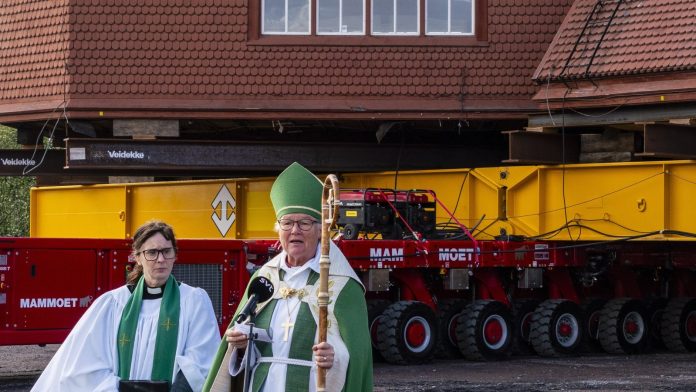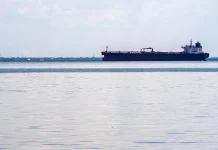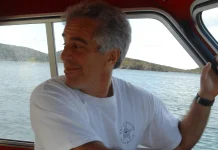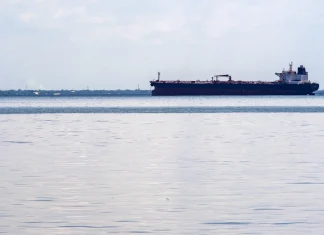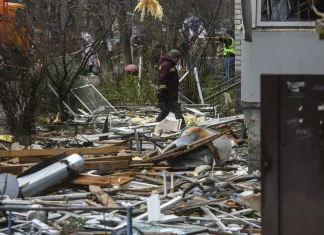The Great Migration of Kiruna Kyrka: Sweden’s Arctic Church on the Move
In the frozen expanses of northern Sweden, where the Arctic winds whisper tales of endurance and change, a remarkable journey has begun. The iconic Kiruna Kyrka, a red wooden beacon of history and spirituality, is gracefully making its way across the rugged landscape—not in centuries, but in real time. This fragile yet sturdy 672-tonne church, a masterpiece built in 1912, is being gently transported five kilometers to a new home. The reason? The relentless hunger of the earth beneath the town, stripped bare by Europe’s largest underground iron ore mine, demands it.
Imagine a wooden giant—40 meters tall—with its neo-Gothic slanting roofs, intricate stained-glass windows casting filtered light, and pews that tell stories inspired by the Indigenous Sami culture—slowly inching forward on remote-controlled flatbed trailers at half a kilometer per hour. It’s not just a move; it’s an extraordinary dance with history, a nod to resilience, and a story of survival played out in red-painted timber and sacred space.
A Town Reshaped by Iron and Time
For nearly two decades, the town of Kiruna—a small Arctic settlement with a population hovering around 18,000—has been reinventing itself. Not by choice, but by necessity. Beneath its streets, tunnels and caverns carved by the giant LKAB iron ore mine have rendered the ground unstable, threatening the very fabric of Kiruna’s existence. The mine breathes iron-rich air into the local economy but slowly undermines the land above.
From 2004 onward, an ambitious relocation plan took root. The entire town center is moving. Buildings once intertwined with daily life—shops, schools, homes, and yes, this towering church—are being carefully carried away to a safer shore. Newly carved roads, expanded from a narrow 9 meters to a generous 24 meters, provide the church’s path. A year’s worth of groundwork to ensure the smoothest ride for this laborious pilgrimage.
On the day the church set forth, a crowd gathered—over 10,000 people lining frozen streets, their breaths visible in the crisp air. Local resident Karin Andersson, who grew up attending services in Kiruna Kyrka, shared, “Watching it move is bittersweet. It feels like a farewell but also a promise. A promise that our history will withstand, wrapped in wood and spirit.”
An Architectural and Cultural Treasure
Kiruna Kyrka is not merely a building; it’s a soul carved in timber and prayer. Designed by Gustaf Wickman, a notable Swedish architect of his time, the structure is an arresting blend of neo-Gothic grandeur and national romanticism. But beyond stylistic flourishes, the church carries the spirit of its people in its very beams. Sami-inspired designs adorn the pews, honoring the Indigenous community whose presence and traditions permeate this region.
The interior houses an exquisite Art Nouveau altarpiece by Prince Eugen of Sweden, a former painter and member of the royal family, whose landscapes evoke the delicate light of Tuscany and the rolling hills of western Sweden. Nearby, the monumental organ, with over 2,000 pipes, stands ready to echo hymns through the new surroundings. Each piece has been cradled and shielded for this unique journey.
“It’s not just a structure or a relic — it’s a living part of our community,” explained LKAB project manager Stefan Holmblad Johansson with reverence. “We knew we couldn’t disassemble it and risk losing that essence. So, we chose to carry it as a whole. A step taken with care, respect, and a deep understanding of its significance.”
The Herculean Task: Moving History
Transporting a 672-tonne wooden cathedral is no small feat. Before the move, engineers and conservationists meticulously examined every inch of the church. Wrapping the organ and altarpiece was a delicate art, a union of craftsmanship and science to preserve furniture and artifacts that have withstood over a century of Arctic winters.
The church was first lifted by inserting giant steel beams underneath while excavating the frozen ground. Two rows of hydraulic trailers were rolled gently beneath, cradling the structure like a precious artifact. As it begins its slow passage, the total load swells to an astonishing 1,200 tonnes.
“This is not a move we do every day—nowhere in the world is something of this scale carried through a small town on its original streets,” remarked Holmblad Johansson. “Usually, such moves happen in industrial ports or areas with vast open spaces. Here, it’s intimate, and that makes it special.”
Next week, the church’s companion—the belltower standing stoically beside it—will follow suit, taking its place in the new Kiruna, as if calling out to the future while echoing memories of the past.
More Than a Move: A Story of Identity and Preservation
Kiruna’s story is more than logistics and engineering marvels; it is a poignant reflection on how communities adapt to forces beyond their control. The costs are significant—relocating the church alone is an estimated 500 million kronor, paid by the mining giant LKAB, whose operations have reshaped the landscape and livelihoods.
Yet, LKAB’s approach speaks to a deeper commitment. Every affected resident is offered compensation or rebuilding alternatives to safeguard their homes and heritage. Cultural buildings like Kiruna Kyrka have been prioritized with an almost sacred responsibility. LKAB’s declaration of this as “a unique event in world history” is not mere rhetoric—it is a recognition that some places transcend their materials, becoming vessels for collective memory and identity.
One cannot help but reflect on the broader contexts of our times as ice melts, cities rise and fall, and natural resources shape destinies. How do we balance preservation and progress? What do we sacrifice—and what do we carry forward? Kiruna’s slow-motion migration dares to answer these questions with a measured, hopeful heart.
As King Carl XVI Gustaf and a national audience watch with bated breath, this red church’s journey is broadcast live—an homage not just to innovation but to patience. It’s slow TV elevated to a grand metaphor, reminding us that sometimes, the longest, most deliberate journeys hold the deepest significance.
Final Thoughts: Witness the Extraordinary
So, dear reader, what does it mean to move a church in the 21st century? To carry a hundred years of faith, artistry, and community pride across a frostbitten landscape? It’s a tale that challenges our notions of permanence in a world in constant flux.
Next time you consider the stone and wood around you, think of Kiruna Kyrka slowly gliding forward against all odds—reminding us all that even when the earth beneath us shifts, some things are worth holding onto, no matter the cost or distance.


